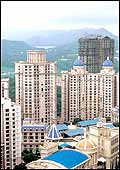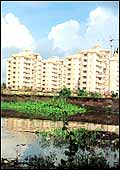|
|
THE
RAMESHS, BANGALORE
UPWARDLY MOBILE
Three years ago, they paid Rs 30 lakh for a two-bedroom apartment
built by total environment. Today, the apartment is worth Rs
45 lakh. Every year 1.5 million families in urban india acquire
homes. |
Meet
the Rameshs: man of the house K. Ramesh is 37, a vice President
at Indiamarkets.com, his wife Pavani, an independent ad-film maker,
and their 31-month old daughter Misha. They live in Bangalore, in
a two-bedroom flat they bought three years ago for around Rs 30
lakh. The developer, IIT Kharagpur alum Kamal Sagar, runs a firm
called Total Environment and has a proclivity to tap literary and
musical sources for the names of the apartments his company develops.
The one in which the Rameshs have a flat, for instance, is named
The Good Earth. Another is called Freebird (after a song by Lynyrd
Skynyrd). And still another, Scarlet Begonias (this, after one by
The Grateful Dead). The Rameshs moved into their flat in 2001-end
and have already seen its value escalate some 50 per cent, not that
they are of a mind to sell.
Still, this article isn't about soaring real
estate prices, or the Rameshs, or new-age builders. At one level,
it is about India's great housing boom. At another, it is about
how people like Ramesh-there were 1.5 million of them last year
in urban India alone; around 5 million in the country as a whole-are
exploiting rising salaries and falling mortgage rates to buy homes.
And at yet another, it is about how everyone from cement and steel
manufacturers to developers to real-estate agents to interior decorators
to furniture retailers benefits from that. In short, it is about
the big H.
The Rameshs in Bangalore, the Singhs in Gurgaon,
Delhi's satellite that is rapidly becoming a city in its own right,
the Raos in Hyderabad, and the Narayanans in Mumbai are part of
the most happening market in contemporary India. Last year, housing
finance companies and banks disbursed over Rs 65,000 crore as home
loans; they expect to do 40 per cent more this year. Then, there's
the market for add-ons: furniture, durables, since most people moving
into a new home replace all or, at the least, a few of their appliances,
and accessories. All told, the market is worth over Rs 100,000 crore,
and that's a conservative estimate. Even better, as Pradeep Seth,
Executive President, Ansal Properties and Industries, a Delhi-based
developer puts it, "(the purchases) are non-speculative and
end-user driven." That means people are buying houses to live
in them, not to rent them out for a year or two and sell them at
a premium when the market looks up. And as Anshuman Magazine, Managing
Director (South Asia) of real estate consultancy C.B. Richard Ellis,
sees it, "With a demand of 30 million housing units in the
next five years, this is one market boom that isn't going to vanish
overnight." He can say that again.
Home A-loan
Five years ago, mortgage rates ranged between
16 per cent and 18 per cent; today, the range is 8.5-10 per cent.
This has coincided with India's growing upwardly mobile population
(2.5 million households actually earn over Rs 3 lakh a year) becoming
debt-friendly. Thus, most housing finance companies have grown at
between 30 per cent and 300 per cent over this period. Five years
ago, market leader HDFC's loan portfolio was worth Rs 3,425 crore;
today, it is Rs 9,951 crore, a CAGR of 30 per cent a year. Mortgages
minnow Vijaya Bank's housing loan portfolio stood at Rs 66 crore
in 2001-02; a year later, it was Rs 482 crore, a growth of 700 per
cent. In the past five years, reckons Niranjan Hiranandani, the
Managing Director of Mumbai-based Hiranandani Constructions, the
market has zoomed from Rs 13,000 crore to Rs 65,000 crore. "My
prediction is," he grins, "it will rise to Rs 120,000
crore in five years."
|
THE EMERGENCE OF THE
SUBURBS
Across Delhi, Mumbai and Kolkata,
the emergence of the suburbs has boosted the housing market.
|
|
|
 |
 |
| Whether it is Delhi's wannabe-city
of a satellite township Gurgaon (left), or Mumbai's Thane (centre)
and Mulund areas, or the area adjoining Kolkata's eastern bypass
(right), suburbia has become a way of life in some cities. |
Cheaper home loans and a debt-friendly populace
are only part of the picture. The other pieces include rising salaries,
especially in telecom, it services, organised retail, biotech, financial
services, and banking sectors, and more rational real-estate prices.
Since 1997-98, claims HDFC, prices have dropped 25-30 per cent.
According to Rajiva Kumar, Executive Director, Omam Consultants,
salaries have grown two-and-a-half to four times since 1997. Not
too long ago people bought homes worth 10-12 times their annual
salaries; today, they buy those priced at thrice their annual salaries,
an indication that affordability has stimulated demand. Banks, flush
with funds dues to poor credit offtake by industry, are diverting
money to their housing divisions.
Just ask S. Manjunath. Allotted a plot of land
by the Bangalore Development Authority, he is being hounded by seven
housing finance companies. "Some are ready to visit me on a
Sunday with all the papers and sanction my loan in 48 hours,"
laughs a bemused Manjunath. Says M.S. Kapur, Managing Director,
Vijaya Bank: ''Banks are rolling in cash with few lending options
available. So, everybody wants a piece of action in housing.'' Despite
this retail aggression, default rates on loans remain a modest 2
per cent. "This is because a house is an emotional purchase
unlike a car or a durable," offers V. Sridhar, the Chairman
and Managing Director of National Housing Bank.
Higher salaries and lower mortgage rates have
engendered another phenomenon, the emergence of the young house
owner. Hiranandani claims that the average age of a person buying
a house has come down from 44 to 30. To these young home-buyers,
the act of spending a few tens of lakhs on acquiring a house isn't
just about creating an asset but a lifestyle statement.
Up-stream And Down-stream Booms
Dharmesh Jain is the King of Mulund. He heads
Nirmal Lifestyle, the largest developer in Mumbai's suburb Mulund
(See India's Most Happening Real Estate Markets). In the past five
years, says Jain, "There has been a five-fold increase in business
for most builders.'' From Shipra Estates, which made a pile by vending
sub-Rs 10 lakh houses on the Delhi-UP border to DLF, which has sold
12,000 flats in Gurgaon thus far, to Mumbai's Hiranandani, to Pune's
Kumar Builders to Kolkata's Calcutta Metropolitan to Bangalore's
Prestige Group to Chennai's Chaitanya Builder and Hyderabad's Ambience
Properties, a clutch of builders that weathered the last real estate
crash (in 1995-96) are seeing their financial statements turn a
very healthy shade of black.
|
INTERIORS IMPLOSION
Furniture and accessory makers
across the country have reaped the effects of the housing
surge.
|
|
|
 |
| Furniture from Spain, flooring
from Sweden, glass from Murano, and shower cabinets from Germany—the
housing boom has created a thriving market for front-end accessories.
P.S.: Price, no bar. |
Up-stream and down-stream industries have benefited
too. "The housing boom has boosted the cement business,"
acknowledges Kiran Nanda, Chief Economist, Gujarat Ambuja. The housing
sector accounts for 16-17 per cent of the 95 million tonnes of cement
consumed annually, and 25 per cent of the 32 million tonnes of steel.
Indeed, entire fortunes have been made in the
construction steel business. Says Mukesh Agarwal, Head, Corporate
Ratings (Cement and Metals) at CRISIL: ''In the last three years,
cement has been growing at 8-10 per cent and steel at 4-5 per cent,
boosted by activity in housing and infrastructure. The outlook for
the sectors is bullish with more people expected to buy houses in
the wake of cheap funds and tax sops.'' Agarwal's reference is to
the fact that interest payments up to Rs 150,000 a year on housing
loans can be deducted from the taxable income. And that's apart
from a rebate of 20 per cent (up to a maximum of Rs 50,000) that
can be availed on principal payments.
A trip down Mehrauli-Gurgaon road in the National
capital region, or into the small lanes branching off Chennai's
Nungambakkam High Road, or even a virtual one through design magazines
should be adequate to prove to even the most die-hard cynic that
there is a boom on in furniture and accessories, the last ranging
from Italian electrical switches to Swedish parqueting to German
shower-cabinets. "We have seen a 25-30 per cent growth year-on-year
for our hi-tech home security systems," says Mehernosh Pithawalla,
a marketing manager at the security equipment division of Godrej
and Boyce. Says K.A. Parameswaran, General Manager (Marketing),
Gautier India: "The housing boom has offset the tech crash's
fall-out." And from architects to interior decorators to Vaastu
consultants, a host of service providers are riding the wave.
Can the housing boom last? Over the next five
years, at the least, it looks like it will. Interest rates are unlikely
to go up and some expect them to soften in the next few months.
Real estate prices are reasonable, with the market displaying none
of the irrational exuberance that preceded the last crash. Executive
salaries will continue to increase, although that is increasingly
a function of performance. What happens beyond that (five years)
is anybody's guess. Still, if the economy grows at over 6 per cent,
interest rates remain low, and prices rational, there's no reason
why the boom can't last for ever.
-with inputs from Moinak Mitra,
T.R. Vivek, Swati Prasad, Dipayan Baishya, Venkatesha Babu,
E. Kumar Sharma, and Nitya Varadarajan
|

